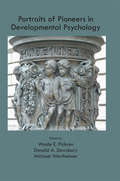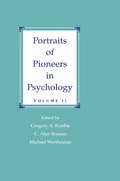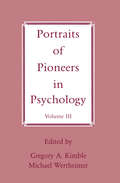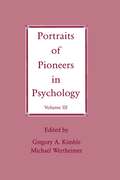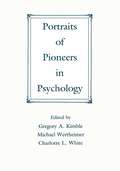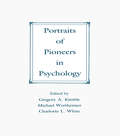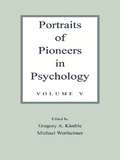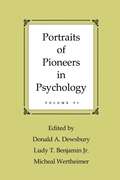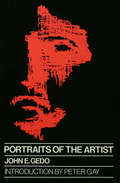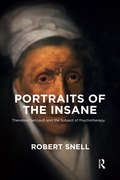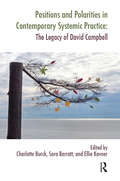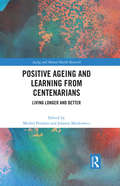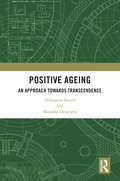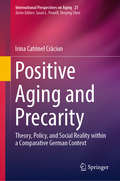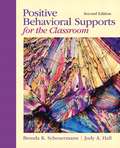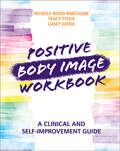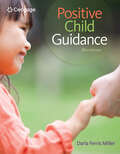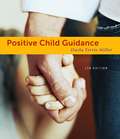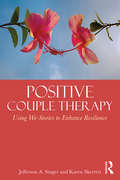- Table View
- List View
Portraits of Pioneers in Developmental Psychology: Volume Vii
by Wade E. Pickren Michael Wertheimer Donald A. DewsburyUtilizing an informal, sometimes humorous style of writing, this book brings to life 16 developmental psychologists who made a significant contribution to their field. Written by noted scholars, each chapter provides a glimpse into the personal and scholarly lives of these innovative "pioneers". Some of the chapters are based on the contributor's personal acquaintance with a pioneer allowing for the introduction of previously unavailable information. Suggested Readings allow readers to delve deeper into the material and a tabular list of subjects and authors helps instructors supplement their courses in substantive areas of psychology with ease. The introductory essay prepares the reader for a deeper understanding of the contributions of each of the pioneers. Mamie Phipps Clark had a profound impact on the education of American children. Robert W. White pioneered a new approach to the study of persons across the lifespan. Lois Barclay Murphy’s perspective on the strengths of developing children foreshadowed later developments in positive psychology. Florence Goodenough pioneered new testing methods for children. John Paul Scott was a pioneer in the field of behavior genetics. The book also highlights the many contributions of European pioneers: Jean Piaget, Charlotte Bühler, Heinz Werner, and Lev Vygotsky. Their contributions were carried forward by J. McVicker Hunt in the U.S. and Helena Antipoff in Brazil. Arnold Gesell’s film studies of children’s development remain a landmark accomplishment. Lawrence Kohlberg pioneered the study of moral development across the lifespan. Roger Barker’s studies on aggression and leadership among children eventually led to the development of ecological psychology. Eleanor "Jackie" Gibson was famous for her work on the "visual cliff" and for her research on perception and development. Finally, Sidney Bijou had a long career delineating ways to improve the lives of children. Pickren’s concluding essay draws connections between the pioneers and how they contributed to the advancement of the field. Intended as a supplementary text for undergraduate and/or graduate courses in the history of psychology and/or developmental, child, or lifespan psychology taught in psychology, education, and human development, this engaging book also appeals to those interested in and/or teaching these subject areas. Each of the 7 volumes in the Portraits of Pioneers Series contain different profiles bringing more than 140 of psychology’s pioneers to life.
Portraits of Pioneers in Psychology: Volume II
by Gregory A. Kimble Michael Wertheimer C. Alan BoneauA major aim of the books in this series is to promote psychology's appreciation of the neglected giants in its history. The chapters document the significance of these early contributions, many of them made more than a century ago. Most of the chapters are revisions of invited addresses delivered at psychological conventions. Several of the authors are students, colleagues, or offspring of their pioneers and all of them are intrigued by the life and work of the psychologists about whom they have written. All of the portraits are informal; on occasion, even humorous. Some are "impersonations"--telling stories in what were or might have been the pioneer's own words. This book provides source materials for teachers of undergraduate courses in psychology--particularly the history of psychology--who want to add a personal view in their lectures and offer interesting readings for their students. Each of the five volumes in this series contains different profiles thereby bringing more than 100 of the pioneers in psychology more vividly to life.
Portraits of Pioneers in Psychology: Volume III (Portraits Of Pioneers In Psychology Ser.)
by Gregory A. Kimble Michael WertheimerThis third volume in a series devoted to luminaries in the history of psychology--features chapter authors who are themselves highly visible and eminent scholars. They provide glimpses of the giants who shaped modern cognitive and behavioral science, and shed new light on their contributions and personalities, often with a touch of humor or whimsy and with fresh personal insights. The animated style, carefully selected details, and lively perspective make the people, ideas, and controversies in the history of psychology come alive. The fields touched on in this and other volumes cover all of the subfields of psychology. As such, all volumes of Portraits of Pioneers in Psychology will be of interest to psychologists, as well as scholars in related fields. The resourceful teacher could use a selection of chapters as supplementary readings to enhance almost any course in the discipline. The major purpose of these books is to provide source materials for students and their teachers in undergraduate and graduate courses in the history of psychology. Each of the five volumes in this series contains different profiles thereby bringing more than 100 of the pioneers in psychology more vividly to life.
Portraits of Pioneers in Psychology: Volume III (Portraits Of Pioneers In Psychology Ser.)
by Gregory A. Kimble Michael WertheimerThis third volume in a series devoted to luminaries in the history of psychology--features chapter authors who are themselves highly visible and eminent scholars. They provide glimpses of the giants who shaped modern cognitive and behavioral science, and shed new light on their contributions and personalities, often with a touch of humor or whimsy and with fresh personal insights. The animated style, carefully selected details, and lively perspective make the people, ideas, and controversies in the history of psychology come alive. The fields touched on in this and other volumes cover all of the subfields of psychology. As such, all volumes of Portraits of Pioneers in Psychology will be of interest to psychologists, as well as scholars in related fields. The resourceful teacher could use a selection of chapters as supplementary readings to enhance almost any course in the discipline. The major purpose of these books is to provide source materials for students and their teachers in undergraduate and graduate courses in the history of psychology. Each of the five volumes in this series contains different profiles thereby bringing more than 100 of the pioneers in psychology more vividly to life.
Portraits of Pioneers in Psychology: Volume IV (Portraits Of Pioneers In Psychology Ser.)
by Gregory A. Kimble Michael WertheimerThis fourth book in the series continues the tradition of the popular earlier volumes by offering lively and entertaining information about some of contemporary psychology's most illustrious ancestors. The 21 chapters, many of them written by today's most visible and eminent authors, concentrate on the lives and achievements of major psychologists from a variety of areas. Created for undergraduate and graduate courses in the history of psychology, the variety of pioneers represented provide enough flexibility to also use it as a supplemental reader in other psychology courses. Each of the five volumes in this series contains different profiles thereby bringing more than 100 of the pioneers in psychology more vividly to life.
Portraits of Pioneers in Psychology: Volume Iii (Portraits Of Pioneers In Psychology Ser.)
by Gregory A. Kimble Michael Wertheimer Charlotte WhiteThis book presents a series of informal biographies about major figures in the history of psychology. A unique combination of expertise and human appeal, the volume places the contributions of each pioneer in a new and fascinating perspective. For instance, several of the authors use the novel approach of having the pioneers return to the present day to reflect back on their work as it relates to the here and now. Revisions of speeches given in a popular series of invited addresses at psychological conventions, the chapters offer appealing glimpses into the lives of individuals who made a difference in the early years of psychology as a field of study. Each of the five volumes in this series contains different profiles thereby bringing more than 100 of the pioneers in psychology more vividly to life.
Portraits of Pioneers in Psychology: Volume Iii (Portraits Of Pioneers In Psychology Ser.)
by Gregory A. Kimble Michael Wertheimer Charlotte WhiteThis book presents a series of informal biographies about major figures in the history of psychology. A unique combination of expertise and human appeal, the volume places the contributions of each pioneer in a new and fascinating perspective. For instance, several of the authors use the novel approach of having the pioneers return to the present day to reflect back on their work as it relates to the here and now. Revisions of speeches given in a popular series of invited addresses at psychological conventions, the chapters offer appealing glimpses into the lives of individuals who made a difference in the early years of psychology as a field of study. Each of the five volumes in this series contains different profiles thereby bringing more than 100 of the pioneers in psychology more vividly to life.
Portraits of Pioneers in Psychology: Volume V
by Gregory A. Kimble Michael WertheimerThis book offers glimpses into the personal and scholarly lives of 20 giants in the history of psychology. As in the earlier volumes, prominent scholars were invited to prepare chapters on a pioneer who had made important contributions in their own area of expertise. Some of the psychologists described may be the teachers of the instructors who will be the users of this book, potentially providing a personal connection of the pioneers to the students. A special section provides brief portraits of the editors and authors, containing interesting information about the relationship between the pioneers and the psychologists who describe them. Utilizing an informal, personal, sometimes humorous, style of writing, the book will appeal to students and instructors interested in the history of psychology. Each of the five volumes in this series contains different profiles thereby bringing more than 100 of the pioneers in psychology more vividly to life.
Portraits of Pioneers in Psychology: Volume VI
by Michael Wertheimer Donald A. Dewsbury Ludy T. Benjamin Jr.This sixth book in the Portraits of Pioneers in Psychology Series preserves the diversity that has characterized earlier volumes as it brings to life psychologists who have made substantial contributions to the field of the history of psychology. These chapters illustrate the pioneering endeavors of such significant figures, and are written in a lively, engaging style by authors who themselves have achieved a reputation as excellent scholars in the history of psychology. Several of the chapters are based on the author's personal acquaintance with a pioneer, and new, previously unavailable information about these luminaries is presented in this volume. Each of these volumes provides glimpses into the personal and scholarly lives of 20 giants in the history of psychology. Prominent scholars provide chapters on a pioneer who made important contributions in their own area of expertise. A special section in each volume provides portraits of the editors and authors, containing interesting information about the relationship between the pioneers and the psychologists who describe them. Utilizing an informal, personal, sometimes humorous, style of writing, the books will appeal to students and instructors interested in the history of psychology. Each of the six volumes in this series contains different profiles, thereby bringing more than 120 of the pioneers in psychology more vividly to life.
Portraits of the Artist: Psychoanalysis of Creativity and its Vicissitudes
by John E. GedoGedo's pathbreaking exploration of the psychology of creativity incorporates first-hand material drawn from his extensive clinical work with artists, musicians, and other exceptionally creative individuals. Using this body of clinical knowledge as conceptual anchorage, he then offers illuminating reassessments of the artistic productivity of van Gogh, Picasso, Gauguin, and Caravaggio, and the literary productivity of Nietzsche, Jung, and Freud.
Portraits of the Insane: Theodore Gericault and the Subject of Psychotherapy
by Robert SnellIn the early 1820s, in the gloomy aftermath of the 1789 Revolution and the Napoleonic wars, the French Romantic painter Theodore Gericault (1791-1824) made five portraits of patients in an asylum or clinic. No depictions of madness before or since can compare with them for humanity, straightforwardness and immediacy. The portraits challenge us to find responses in ourselves to the face and the embodied mysteries of the other person, and to our own internal (unsconscious, disavowed) otherness: in this sense, Gericault was a "painter-analyst". The challenge could not be more urgent, in our world of suspicion of the stranger, and of the medicalisation of madness. The book sketches the history of this last process, from the Enlightenment through to the Revolution and its public health policies, to the birth of the asylum in its interface with the penal system. But there was also a new medico-philosophical conviction that the mad were never wholly mad, and their suffering and disturbance might best be addressed through relationship and speech.
Positions and Polarities in Contemporary Systemic Practice: The Legacy of David Campbell (The Systemic Thinking and Practice Series)
by Sara Barratt Charlotte Burck Ellie KavnerThis book provides a rich collection of the work that has been informed by the ideas of the eminent family therapist and clinical psychologist, Dr David Campbell who died in August 2009. Contributors are drawn from different fields and describe models they have developed for organizational consultation, training, therapy and research. The book includes a range of important topics, key ideas which thread through contemporary theoretical frameworks, a research study into young people's experience of parental mental illness, and the application of Dr Campbell's use of semantic polarity theory in supervision, research and clinical practice. The innovative consultancy model developed by David Campbell with Marianne Groenbaek is elaborated here. Personal accounts of work in different contexts include a priest consulting within his community, the use of self in training systemic psychotherapists, the experience of consultation in academic settings, and a narrative of a training course for psychiatrists. Interspersed with these chapters are David Campbell's own reflections concerning the development of his ideas and practice over time.
Positive Ageing and Learning from Centenarians: Living Longer and Better (Aging and Mental Health Research)
by Michel PoulainPositive Ageing and Learning from Centenarians evaluates the mechanisms of positive ageing in a uniquely interdisciplinary way to explore the question of how we age and how some people age successfully. Drawing together the findings of recognised longevity researchers from around the world, the book applies an integrated vision to educational and social aspects of human ageing. It examines research into centenarians, and considers most of the disciplines related to longevity and healthy aging and aspects such as education, psychology, philosophy, anthropology, demography, sociology, economics as well as those related to nutrition and biological factors of longevity. The book examines how the results of these scientific investigations could improve the well-being of the oldest olds in the future, especially in the context of ageing societies. It provides an answer to the question of what we can learn from centenarians and what lessons we can from their lifestyle, which can contribute to live longer, better and happier. Based on cutting-edge research, the book will be highly relevant reading for researchers, academics and students in the field of ageing and longevity, mental health research, health science, gerontology and psychology.
Positive Ageing: An Approach Towards Transcendence
by Nilanjana Sanyal Manisha DasguptaThis book presents a kaleidoscopic view of the positive layers of ageing as well as key interventions that can help generate and maintain positivity and well-being among the elderly. It explores the connections of ageing with spirituality, nature and existentialism, and leisure to encourage creativity, individuation, happiness and emotional detachment. It further examines various interventions such as end-of-life care, mindfulness and yoga, retrospection and life-review, etc. which may improve the overall quality of life by promoting the health of the elderly. The book focuses on authentic ageing, transpersonal gerontology, the concept of elder child, geriatric interventions, and caregiving, and suggests practical improvements in health and facilities for the elderly. It also covers aspects of the inner life of the prolonged ailing or dying person from a mental health perspective and emphasizes on the value of positive ageing. A guide to applied geriatrics and geriatric psychology, with its simple style and clear methods in end-to-end praxis, the book shows how mental well-being can be fostered in the elderly to help them find meaning and purpose in old age. This book will interest students, teachers and researchers of psychology, positive psychology, geropsychology and gerontological studies, sociology and social work, public health, medical education and geriatric nursing. It will also be useful to practitioners including psychologists, counsellors, gerontologists, mental health professionals and NGOs working with the elderly, and the interested reader.
Positive Aging and Precarity: Theory, Policy, and Social Reality within a Comparative German Context (International Perspectives on Aging #21)
by Irina Catrinel CrăciunThis book explores positive aging through the lens of precarity, aiming to ground positive aging theories in current social contexts. In recent years, research on aging has been branded by growing disagreements between supporters of the successful aging model and critical gerontologists who highlight the widening inequalities, disadvantages and precarity that characterize old age. This book comes to fill a gap in knowledge by offering an alternative view on positive aging, informed by precarity and its impact on projections concerning aging.The first part of the book places aging in broader theoretical and empirical context, exploring the complex links between views on aging, successful aging theories, policy and social reality. The second part uses results from a qualitative research conducted in Germany to illustrate the dissonance between successful aging ideals and both negative and positive views on aging as well as aging preparation strategies inspired by precarity. Findings from this section provide a solid starting point for comparisons with countries that are both similar and different from Germany in terms of welfare regimes and aging policies. The final part of the book discusses the psychological implications of these findings within and beyond the German case study and outlines potential solutions for practice. This book provides health psychologists, gerontologists, sociologists, social workers, health professionals as well as students and aging individuals themselves with better understanding of the meaning of aging in precarious times and builds confidence about aging well despite precarity.
Positive Aging: A Guide for Mental Health Professionals and Consumers
by Robert D. Hill<p>Retirement, senility, disability, and death were all notions previously associated with growing old. <p>Today, with the average life span of men and women in the United States exceeding 76 years, the words successful, optimal, and positive dominate the lexicon of scientists and, increasingly, the general public. We not only plan to live longer, but expect to enjoy a superior standard of physical and emotional health for longer than any previous generation. Leading an active and purposeful life no longer stops at the outdated 65-year mark of retirement, but continues well into what was once termed "old age." With these changing attitudes comes the need for new conceptualizations of what it means to grow old. <p>In a groundbreaking book, Robert Hill, a psychologist, professor, and leading researcher in geriatric care, rethinks the traditional ideas we have of aging by offering us a new framework from which to understand the nature of growing old. Positive Aging offers a more innovative model of old age that focuses on achieving and fostering a positive mindset. In doing so, Hill not only explores the social and psychological trends of aging in the 21st century, but offers an illuminating examination of how advances in the science of gerontology influence the phenomenology of growing old. <p>Written for all those concerned about their own course of aging as well as the practitioner who provides mental health services to older adults, Positive Aging begins with a review of the term "aging" itself, its history and its changing meaning. Hill then delves into the many lifestyle choices we can make to improve our happiness as we grow older. Traditional theories of adult development and how Positive Aging plays into them are examined; successful, normal, impaired, and diseased trajectories of age-related decline are defined and explored; and useful strategies are provided for coping with common old-age issues—including cognitive deficits, depression, anxiety, and psychological barriers to happiness. Hill also covers important late-life concerns such as the role Positive Aging plays in physical disability, caregiving, grief, bereavement, death, and spirituality and meaning-based counseling. Along the way, poignant case studies help elucidate and contextualize the arguments, and keep the discussion rooted in very tangible, human terms. <p>Ushering in an era of new understanding of what it means to grow older, Positive Aging is an enlightening guidebook for consumers navigating such uncertain, and often worrisome terrain, as well as an invaluable resource for clinicians working with this growing population. By combining a novel approach to human aging in the contemporary world with specific suggestions and ideas to optimize that process, this book promises to help all of us cope with the vicissitudes of growing older to continue to get the most out of living.</p>
Positive Art Therapy Theory and Practice: Integrating Positive Psychology with Art Therapy
by Rebecca Ann Wilkinson Gioia ChiltonPositive Art Therapy Theory and Practice outlines a clear, systematic approach for combining positive psychology with art therapy’s capacity to mobilize client strengths; induce engagement, flow and positive emotions; transform perceptions; build healing relationships and empowering narratives; and illuminate life purpose and meaning. Woven throughout are clinical illustrations, state-of-the-art research, discussion questions, and reflections on how therapists can apply this approach to their work with clients, and their personal and professional development. The book also includes a comprehensive list of more than 80 positive art therapy directives, a robust glossary, and lists of strengths and values. Written in an inviting and amusing style, this manual is both entertaining and practical—an invaluable tool for any practitioner looking to apply the most current theory and research on positive psychology and art therapy to their clinical practice.
Positive Balance: A Theory of Well-Being and Positive Mental Health (Social Indicators Research Series #80)
by M. Joseph SirgyThe book provides a new theory of well-being designed to integrate many disparate concepts of well-being, such as subjective well-being, personal happiness, mental well-being, emotional well-being, psychological well-being, hedonic well-being, social well-being, life satisfaction, domain satisfaction, and eudaimonia. It lays the foundation for a new a theory of mental well-being based on a hierarchical perspective of positive mental health and guided by the concept of positive balance.Written by a well-known expert in the field, this book addresses the issue of positive balance related to physiological, emotional, cognitive, meta-cognitive, developmental and social-ecological levels of an individual and analyses the factors at each level that contribute to an individual’s positive mental health experience. It discusses in detail the effects of neurochemicals such as dopamine, serotonin, or cortisol; positive and negative affect; satisfaction in salient and multiple life domains vis-à-vis dissatisfaction in life domains; positive versus negative evaluations about one’s life using certain standards of comparison; positive psychological traits of personal growth and intrinsic motivation, etc. vis-à-vis negative traits like pessimism and impulsiveness; and perceived social resources like social contribution and social actualization vis-à-vis perceived constraints like exclusion and ostracism. This original work is of interest to students, researchers and practitioners of quality of life and wellbeing studies, positive psychology, developmental psychology and mental health..
Positive Behavioral Supports for the Classroom
by Brenda K. Scheuermann Judy A. HallThe field of positive behavioral intervention and support is expanding rapidly, and the revised and reorganized second edition of Positive Behavioral Supports for the Classroom reflects the newest research and most exciting advances. With a new emphasis on the three-tier response-to-intervention model, the text continues to deliver readers an array of research-based strategies and techniques for strengthening appropriate behaviors and reducing challenging ones. Tackling both the "hows" and "whys" of behavioral management in the classroom, this text combines theory and practice in a way that helps students understand and apply effective strategies for behavioral support, assessment, and intervention in both school-wide settings and on an individual basis.
Positive Behavioral Supports for the Classroom, Fourth Edition
by Brenda K. Scheuermann Judy A. Hall Glenna M. BillingsleyThis book covers foundational principles and practices from applied behavior analysis. It includes the latest research and practices from the field of positive behavior interventions and supports. The text emphasizes a multi-tiered support system for developing positive behaviors in children and youth. A wide variety of concepts and techniques are examined. The authors' relaxed, user-friendly writing style makes the book appropriate for everyone. The 4th Edition features updated research and recent developments in the field. It places extra focus on preventing challenging behaviors. You'll learn how to manage challenging behaviors effectively school-wide, in classrooms and for individual students.
Positive Body Image Workbook: A Clinical and Self-Improvement Guide
by Tracy Tylka Nichole Wood-Barcalow Casey JudgeThis clear and easy-to-use workbook provides clinicians, clients, and those interested in self-improvement with a practical guide to understanding and improving body image through the latest research findings and clinical tools. The key components of positive body image, such as embodiment, body appreciation, self-care, intuitive eating, social comparison, and body talk, are all covered, with reliable assessments and guidelines for applications accompanying each topic. An array of assignments are also included for clients and readers to complete based on their values, needs and interests to provide positive body image. Clinicians will appreciate the practical treatment planning sections (including talking points for sessions, goals and objectives) to assist in clinical interventions. Additionally, a specific chapter is devoted to how clinicians can prepare themselves both professionally and personally for body image work.
Positive Child Guidance
by Darla Ferris MillerPOSITIVE CHILD GUIDANCE, Eighth Edition, equips readers with information on how to guide, manage, and cope with the behavior of children. The book provides insight into children's efforts to understand their own emerging needs and feelings while coping with adult expectations. The author outlines workable steps for creating a cooperative, respectful community of children and adults, with special emphasis on sensitivity to cultural needs, cultural differences, and developmentally appropriate practice. You'll also find a range of practical, effective, and flexible guidance strategies based on principles of straightforward communication and assertiveness. This new edition includes critical advances in research and addresses the cultural trends that are changing the way babies and children are cared for today.
Positive Child Guidance (Seventh Edition)
by Darla Ferris MillerPositive Child Guidance, Seventh Edition is ideal for guidance, behavior management and discipline, and classroom management courses in an early childhood education curriculum. This practical book outlines workable steps for creating a cooperative, respectful community of children and adults with special emphasis on sensitivity to cultural needs, cultural differences, and developmentally appropriate practice.
Positive Couple Therapy: Using We-Stories to Enhance Resilience
by Jefferson A. Singer Karen SkerrettPositive Couple Therapy: Using We-Stories to Enhance Resilience is a significant step forward in the couple literature. Utilizing a strengths-based approach, it teaches therapists and couples a unique method for uncovering positive potential within a relationship. The authors demonstrate how “We stories”–created, recovered and made anew–provide essential elements of connection. With vivid imagery, these stories capture the couple’s sense of “We-ness,” highlighting memorable moments of compassion, acceptance, and respect. A shared commitment to the “We” simultaneously builds the relationship and enables each individual in the partnership to feel a greater degree of both accountability and autonomy. Couples that can find their stories, share them with each other, and then carry them forward to family, friends, and a larger community are likely to preserve a sense of mutuality that will thrive over a lifetime of partnership. Positive Couple Therapy provides simple and practical instruction for reclaiming positive stories that can catalyze hope in relationships that have become stressed and strained. The authors weave together cutting edge thinking and research in attachment theory, narrative therapy, neuroscience, and adult development, as well as their own research and clinical experience to present vivid case histories, step-by-step strategies, exercises, questionnaires, and interview techniques. They cover a range of contemporary couple experiences: couples in conflict, LGBT partnerships, deployed and discharged military couples, and couples at various points across the life span. The authors’ unique Me (to US) Scale, a 10-item tool that assesses the degree of mutuality a couple possesses at the start of treatment, gives therapists of any theoretical orientation the ability to put this intervention to immediate use.
Positive Discipline for Preschoolers, Revised 4th Edition: For Their Early Years -- Raising Children Who Are Responsible, Respectful, and Resourceful
by Jane Nelsen Cheryl Erwin Roslyn Ann DuffyCompletely updated with the latest research in child development and learning, Positive Discipline for Preschoolers will help parents understand their preschooler and provide early methods to raise a child who is responsible, respectful, and resourceful.Caring for young children is one of the most challenging tasks an adult will ever face. No matter how much you love your child, there will be moments filled with frustration, anger, and even desperation. There will also be questions: Why does my four-year-old deliberately lie to me? Why is everything a struggle with my three-year-old? Should I ever spank my preschooler when she is disobedient? Over the years, millions of parents have come to trust the Positive Discipline series and its common-sense approach to child-rearing.This revised and updated fourth edition includes a new chapter on the importance of play and outdoor experiences on child development, along with new information on school readiness, childhood brain growth, and social/emotional learning. You'll also find practical solutions for how to:- Teach appropriate social skills at an early age- Avoid the power struggles that often come with mastering sleeping, eating, and potty training- See misbehavior as an opportunity to teach nonpunitive discipline--not punishment
